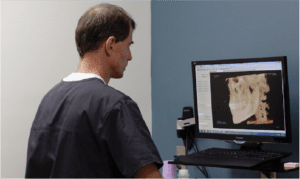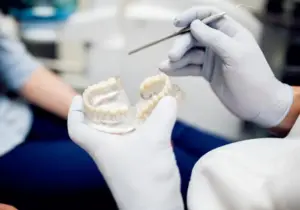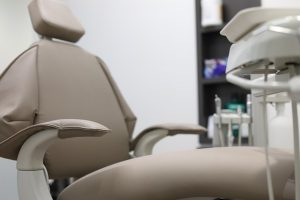The help you get from your oral surgeon to recover from a dental procedure should be about more than pain management. Sometimes, after facial trauma, dental implant or wisdom tooth surgery, our body needs a bit of help healing. And the best way to help someone heal is holistically, which is where regenerative medicine in.
Biologics are a new field of medical intervention for tissue healing, repair and restoration, and are produced using the patient’s own biomaterials. This can mean many things. For instance, dentin bone grafting recycles native boney tissue in order to speed healing and encourage bone growth at the site. Or injections of a patient’s own stem cells, which can be used to treat soft tissue damage, including cartilage.
At Wilmington Oral Surgery, we take every measure to stay on top of these exciting advances in oral medicine, which help us offer holistic care that increases efficacy, healing and patient comfort. We strive for this in our surgical methods as well as our approach to recovering from oral surgery. Among the natural treatments we offer patients are red light therapy, the StellaLife VEGA Recovery Kit, and platelet-rich-fibrin.
What is Platelet-Rich-Fibrin?
PRF is a natural, autologous (derived from the patient’s own blood) biomaterial concentrated in growth factors and cells that play a crucial role in tissue regeneration. Unlike platelet-rich plasma (PRP), another popular blood-derived therapy, PRF is rich in leukocytes, contributing to enhanced immune response and reduced infection risk. This unique composition makes PRF a valuable asset in enhancing healing and improving outcomes in oral surgery.
A concentrated mesh of platelet-rich cells, PRF is beneficial in both hard tissue and soft tissue procedures. The slow and gradual release of growth factors improves tissue regeneration. Even better, PRF can be used alongside dental bone grafts. The advantages of PRF help us maximize healing and minimize patient discomfort, which is why Wilmington Oral Surgery now offers advanced-PRF for our patients.
Benefits of Utilizing PRF in an Holistic Approach to Oral Surgery
Regenerative medicine is fast proving an effective method of boosting your body’s healing processes, which offers patients several advantages:
- PRF’s growth factors stimulate cell proliferation and migration, promoting faster tissue regeneration and wound healing.
- PRF’s anti-inflammatory properties help minimize post-operative pain and swelling, leading to a more comfortable recovery experience for patients.
- PRF is particularly effective in promoting bone growth, making it ideal for bone grafting procedures in implant placement, jaw reconstruction and sinus augmentation.
- The concentration of leukocytes in PRF combats bacterial infections, reducing the risk of post-operative complications like infection or bone degeneration.
- PRF can be used to promote faster and more complete healing of soft tissues like gums and oral mucosa, enhancing overall surgical outcomes.
- With faster healing, reduced pain and antibacterial properties, PRF minimizes post-operative complications, ultimately resulting in better patient results.
What’s the Process of Adding a PRF Treatment to a Surgical Procedure?
The process of creating platelet-rich-fibrin is simple, requires no foreign substances like coagulators, and happens right in our office. As well, the blood sample needed is small. After we extract the patient’s blood, the sample is put in a centrifuge for about 10 minutes. This separates the different components of your blood into 3 layers.
The top layer is a platelet concentrate, the lower layer are the red blood cells, and the middle layer is the platelet-rich-fibrin. It’s essentially a tonne of platelets trapped in a fibrin mesh, and has a concentration of platelets 10x the normal level in the blood.
Platelets are chocked full of growth factors – the cells that promote healing and tissue regeneration. The extracted PRF is then applied to the wound from the oral procedure or along with a dental or soft tissue graft, where it settles and serves as a nutrient source and a signal for the body to send even more healing efforts to the area.
Safety Advantages of PRF in Oral Surgery Recovery
As opposed to steroids and other pharmaceuticals, which are manmade and come with potential for nasty side effects, utilizing PRF in oral and maxillofacial surgeries presents several safety advantages:
- No foreign body reaction – since the PRF is made from the patient’s own cells, there is nearly no risk of disease transmission or rejection.
- Release of growth factors – a number of growth factors are gradually released from the PRF. Three prominent factors (VEGF, PDGF, and TGF-beta) play critical roles in the healing process.
- White blood cells are involved – leukocytes (white blood cells) are incorporated into the PRF, which also provide growth factors and protect against infection.
- Minimal blood manipulation – previous generations of platelet-rich treatments required additives and extra intervention in preparing the blood. PRF treatments don’t, which is why they have higher success and safety in clinical uses.
PRF and Healing from Mouth Surgery: Clinical Applications
The other features of platelet-rich-fibrin that make it such an advantageous and natural way to help patients heal from their mouth surgeries are two-fold. One, it’s a quick, in-office treatment that doesn’t require an additional procedure. Two, PRF offers a wide array of applications:
- Regeneration of bone at the time of tooth removal– PRF placed into the extraction site.
- Regeneration of bone in areas of bone deficiency – PRF can be combined with the bone grafting materials, and also used as a membrane over the grafting.
- PRF can be utilized for sinus grafting, to protect the sinus lining and also help stabilize the grafting materials.
- Immediate implant placement – PRF works well to fill in minor gaps between the implant and native bone.
- Soft tissue grafting – PRF promotes soft tissue healing and helps to minimize tissue inflammation.
- Bone regeneration after removal of cysts.
- Closure of sinus communication or fistula.
- A recent case report used PRF to treat medication-associated osteonecrosis (i.e. – Fosamax) – these cases of osteonecrosis have been very difficult to treat with predictable results.
Optimizing PRF with Thorough Post-Op Care
As with any kind of surgery, patients need to do their part to aid in their recovery – it helps your body and the PRF perform their best. We suggest to our patients to take the following steps after oral surgery:
- Avoid drinking anything that requires sucking through a straw.
- Avoid strenuous activities; they require you to put strain on the muscles in your face.
- Brush and floss gently, and never directly over the area (i.e. dental implant site, wisdom tooth extraction site, etc.).
- Don’t consume tobacco.
- Gently swish with warm salt water a couple times a day.
- Use natural treatments like garlic and clove oil to prevent infection and lessen pain.
Patient-Focused, Gentle Care Before, During & After Oral Surgery
Our maxillofacial surgery practice prides itself on our skilled oral surgeon and our staff’s ability to provide gentle oral care that makes the patient’s experience a priority. Careful assessment, detailed planning, and an efficient process throughout the oral surgery means less anxiety, pain and healing time for our patients, no matter how invasive the surgical procedure on your mouth is.
Proper at-home aftercare for any oral surgery is key once you get home from our office, but we make sure you start off your healing in the best condition. And any questions or concerns you have throughout the process? Give us a call any time.









